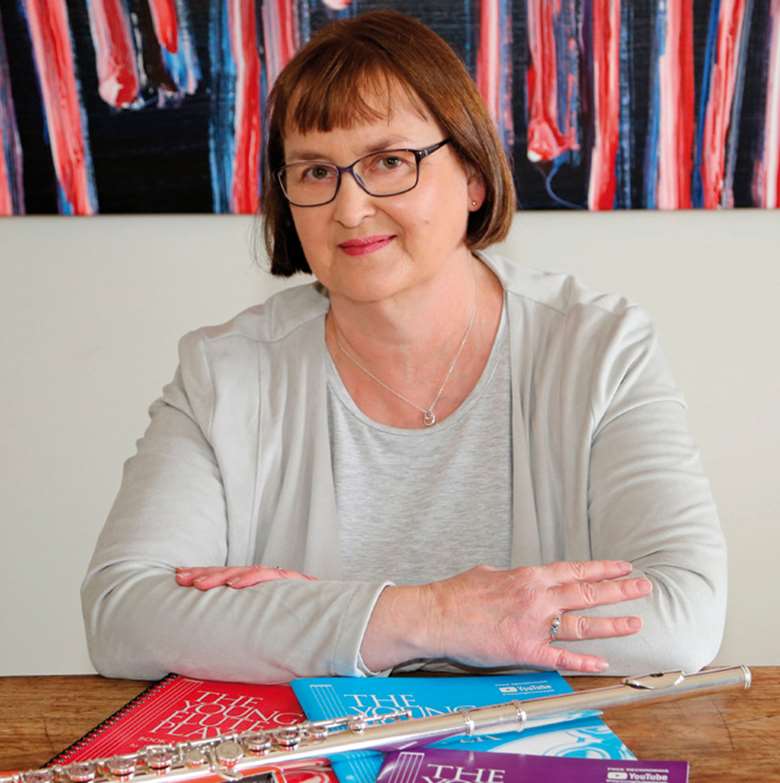Q&A: Karen North
Harriet Clifford
Monday, February 1, 2021
Teacher, musician and author of The Young Flute Player collection, Karen North has been teaching children and adults the flute in Australia for over 35 years. Harriet Clifford catches up with her.

HC: Can you tell me a bit about your The Young Flute Player books?
KN: The collection has seven books so far – there are two beginner books, one for children, one for adults, then a method book for Grades 1–3 and a teacher's book of accompaniments. For ensembles there are two books of duets and trios, with colour coded music to help young players follow their part.
The latest book is festive music – solos, duets and trios to celebrate Christmas, New Year, Halloween and many other festivals. I also have a YouTube channel with free recordings of every piece in the books, which has been extremely popular in the past year for online teaching.
HC: What was the initial inspiration behind the books?
KN: Many, many years ago when I started teaching flute, the method books were best suited to children from about 12 years of age. I wanted to create a book which was suitable for children from the age of 8 or 9, which moved at a more gradual pace, with pages that looked inviting, music that was enjoyable, and varied activities to keep young students interested. I also wanted to put everything they needed into one book, so I included things like manuscript paper, practice charts and some theory.
HC: What's your own background in music and education?
KN: As a child I was lucky to go to schools with lots of music – in addition to singing in choirs I was able to learn six instruments. At university I studied music, then did my teaching qualifications and started full-time teaching, plus I did a Master of Music degree at night. I mainly taught in the classroom, plus flute teaching and conducting performances, until I had a stroke at the age of 30, which put a temporary halt on things for a few years.
HC: What, in your opinion, are the main benefits of learning an instrument at an early age?
KN: The main benefit would be to experience the joy of making music. Also, many studies are showing that learning an instrument helps children with learning in other areas, such as coordination, discipline, reading and creativity, so I suppose there are both intrinsic and extrinsic benefits to learning an instrument.
HC: You also have a book of games for use in instrumental lessons. What's your view on the importance of fun in music teaching?
KN: I think fun is absolutely essential, both for the students and the teacher! If we enjoy something, we learn better, so I use games a lot in both instrumental teaching and in the classroom. In over 35 years of teaching, I've never had a student reluctant to play a game – usually it's, ‘Can we do it again please?’
HC: In your experience, what are the main barriers to young people learning instruments such as the flute?
KN: Probably the cost of an instrument. Some students have access to school instruments or a hire programme – if not, even a basic student flute is expensive. In the past few years, I've started teaching younger children on plastic flutes or mini flutes (Toots) and this is working really well. The sound is obviously not as good, but it's a great starting point, and if they're keen to continue, they can move to a silver flute when they're older.
HC: What would you say about the accessibility of The Young Flute Player collection?
KN: The books cater for a range of ages and abilities, from six years to adults. My next book, due out in early 2021, will go up to Grade 4. I've also tried to draw on music from a number of cultures – for example my latest book, Festive Flute Fun, includes music from over 20 countries. This was really interesting to research as I found out a lot about festivals in other cultures and there were really lovely pieces of music I hadn't heard before – I really enjoyed arranging them.
HC: What one piece of advice would you give to flute teachers during the pandemic?
KN: I think the most important thing to remember is to be flexible – with your students, yourself, and your expectations. The rules keep changing and we just need to go with the flow. Flute teachers have adapted really well to teaching online – it's harder than in-person lessons, and you have to do some things differently, but it still works. I started a free newsletter last March to support music teachers with ideas of how to adapt their lessons, including things like teaching class music without singing. There are so many ways we can approach teaching and it's been fun to explore how we can adapt to the ‘new normal’.
Visit www.theyoungfluteplayer.com to find out more about Karen's books and add your name to her newsletter list.

